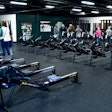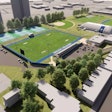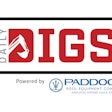
Major construction projects often represent once-in-a-career visioning opportunities for those who will ultimately occupy the new building, and the process will likely span several years from concept to completion. Selecting the ideal architect (or architects) to partner with throughout that process may rank among the most important decisions an organization will ever make. The stakes are high. Failure to get it right means living with — and in — the end result of that decision for decades to come.
"Selecting an architect is like jumping into a pool. You can't partially do so," says RDG Planning & Design principal Jack Patton. "When you are confident the water temperature is right, the lane is clear, and the workout will be great, you need to commit."
AB asked several architects with extensive athletics, fitness and recreation resumes for their advice to would-be clients and discovered several common themes among their suggested selection criteria. Here are five factors that warrant particular attention:
1. Preplan
Even before the selection process is initiated and requests for quotations are made, the owner organization should take time outlining the entire process that lies ahead, including the project's goals, scope, timelines, contractual expectations and desired outcomes, according to CannonDesign principal Colleen McKenna. "A well-developed RFQ will lay the groundwork for the selection process and help the design teams to better understand if they are the right fit for a project based upon the information provided by the owner," McKenna says. "An incomplete RFQ will only cause confusion and may not yield the best partner."
"Beginning with a study or concept design phase to determine the scope of work, budget, schedule, project goals and overall feasibility can be a relatively small initial investment with a high end-value," says Chris Sgarzi, a principal at Sasaki. "In the process, you make some of the most important decisions that will set the course for the rest of the project."
Completing that process will make identifying a pool of potential partners easier, Sgarzi adds. "Search for perhaps eight to 12 firms that have worked with similar institutions, completed similar building types, or simply have demonstrated interesting and provocative design results that seem relevant to what your institution wants to achieve," he says. "Supply this group with the intent of the project and any known parameters."
Any given project may have unknowns — unforeseen factors that influence decisions down the line. An architect's demonstrated ability to deal with change on the fly should be seen as an asset. "We all prefer that project scopes be defined as much as possible by tangible programs, budgets, expectations, schedules, priorities, etc.," says Troy Sherrard, partner and practice leader for sports and recreation architecture at Moody Nolan. "Yet, the world of design by its nature is not a linear process and requires necessary and ongoing design feedback loops to create a successful and informed solution. A good architect remains open to alternative creative paths to success in responding to each client's unique process and personality."
2. Dialogue
"Fit" and "chemistry" are words used frequently when architects discuss what makes for an ideal architect-client relationship. "The reality is that you will be working closely with this group of professionals for the next several years," says Clint Menefee, studio leader at SmithGroupJJR. "Do you enjoy being around them? Is the process engaging and fun? The answer has to be a resounding yes."
"The majority of architects can deliver a building that will meet the basic functional needs of their clients. The most valuable architects go beyond this functional baseline to create facilities that help its users excel." |
The process doesn't have to be entirely harmonious to be productive, however. Menefee adds that effective architects are often those who play the role of challenger-advocate. "Consider a design team that will challenge assumptions, even your own, while asking the tough questions in an effort to discover the best solution to any challenge," he says. "A challenger-advocate will fight for what is best for the project from start to finish."
"Ask the tough questions, too," James Braam, senior vice president at HOK, advises would-be clients. "As architects, we enjoy the dialogue, and it helps us better understand your specific considerations and vision."
Indeed, commitment goes both ways and collaboration is key. "Look for architects who show genuine interest and commitment to your project," says Kalman Nagy, a design director and associate at Dewberry. "Those qualities will lead to better projects and a stronger likelihood that you'll enjoy the experience. Building design and construction projects can last for years, so it is important to find a design team that truly wants to work with you."
Sherrard recommends meeting with architects willing to leave ego at the door. "You need a partner, not a prima donna," he says. "True teamwork and collaboration skills are critical in today's design space. The world is growing, changing and evolving every day. A good architect knows when to harvest the great ideas from the group and park those that need time to grow."
Willingness of the architect to listen should be assessed from the very first interaction. "The best architectural firms understand the importance of starting with a robust and collaborative visioning session to ensure there is a synthesized vision from the project team," says David Sorg, a principal at OPN Architects. "This vision will demonstrate where the client is today and where they are headed. It defines what project success looks like and establishes guiding principles. It is critical to successful programming, schematic design and everything that follows."
3. Experience
As with most aspects of life and business, there is no substitute for relevant experience. "Institutions and municipalities should not be expected to finance the learning curve for its design team to get up to speed with the latest industry trends and technical requirements of their specific project type," says Keith Russeau, a principal at The Collaborative. "Rather, the investment in discovery should be centered on understanding the culture of the institution and distilling its goals, challenges and project-specific needs. At the same time, it's important to look for an architect who is uninterested in drawing similar design solutions from past projects. You want to find an architect who will draw on years of experience to craft a creative and unique solution to your project."
No two projects are alike, and some aren't even close. Says Lynn Reda, a principal at HG Architects, "If you have a renovation and addition project, there are challenges associated with that type of work that won't be present in completely new construction."
This search for relevant experience should cover not only the firm at large, but its individuals, too. "Make sure the work being presented was done by the people presenting it, and make sure that the people in the proposal and in the interview cannot be substituted without owner approval," says Ernest Joyner, a principal at Perkins+Will, where he also serves as director of operations. "A typical design schedule can last for a year or more and can be a stressful experience for all. Think about who you want to work with in a direct, personal way over such a long and intense duration."
Moreover, finding expertise may mean seeking contributions to the project from more than one firm. "Nuances of the facility typology, funding mechanisms and stakeholder involvement means it's key to have an established expert to lead the project," Braam says, adding, "If having a local firm involved is important, you can always request they have a partner."
McKenna agrees. "The ideal scenario is one where the design team has a portfolio and experience that complements an owner's goals," she says. "This may result in multiple firms partnering to bring together the best combination of skillsets, experience and design for a project."
4. References
With experience comes a tangible track record, and would-be clients should take the time to interview end-users or visit in person projects that closely match their own vision. "There is a sentiment out there that calling references is a waste of time, because why would any architect list someone who is a bad reference?" Joyner says. "The wrinkle here is that architects want to put their most relevant work in the proposal, and so if they have a questionable reference, they may include it anyway because the project is so strong. There is also more nuanced information to be gained from past clients, such as strengths and weaknesses. If you like one design team but have reservations about one particular team member or area of expertise, it is a good opportunity to check up on it."
"Consider taking it one step further and call on clients who may not have been listed under the architect's references," says Russeau, who further suggests sending questions in advance of a reference call to get the most thoughtful responses. "Institutions are generally interested in sharing lessons learned for the betterment of the broader community, so use this reference call to not only inquire about the performance of your prospective architect, but also probe for potential lessons learned to better position your internal team."
5. Costs
Saving the primary concern of most project stakeholders for last, cost is one factor that should be scrutinized when checking references. "A large disparity between the construction cost at the beginning and the construction cost at the end does not reveal if there were a lot of mistakes, or another floor was added to the project during construction," Joyner warns. "It pays to be specific and ask for the Errors and Omissions Change Order record on any given project."
All of the aforementioned considerations will help get a handle on the project's final price tag. "The more an architect understands your desired process, schedule and expectations for results, the more accurately they can propose a fee to cover the work," Sgarzi says. "In the end, the project will not benefit if the architect's fee is too low to complete the assignment in the manner you expect. However, you must be fiscally responsible and naturally desire to get the most for your investment. To that end, it's helpful to request a fee proposal and negotiate when the project is still in a competitive situation. In many cases, the difference in fees between potential firms may not be worth selecting a firm other than the favorite based on qualifications and fit. The difference in these fees will likely represent a small percentage of the cost that is ultimately spent on the entire project, and the difference in design results could be vast."
McKenna cautions that if an architect's quoted fee seems too good to be true, it probably is. "If all the fees from the various firms submitting on a project are relatively close to one another, then an owner can feel confident that the scope of work was well-defined," she says. "If the fee spread is vast, the owner should take a second look at exactly what is being asked and even consider redefining the scope of work in greater detail to bring clarity to what's desired. This will result in more-accurate fee proposals from the various design teams. If the price seems too good to be true, then something is probably not quite right and you may end up paying more in the end."
Opsis principal Paul Kinley is quick to point out that up-front costs are only part of the equation. "Clients or potential clients who are considering a recreation center often focus on the capital side of the cost equation and underestimate the operations cost," Kinley says. "These facilities are operationally intensive and often struggle to generate enough revenue to adequately cover both the capital investment and the ongoing operation cost. The consideration of any recreation center, particularly for municipalities, should begin with a thorough and detailed feasibility study, including programming, site analysis, market study, conceptual design and cost analysis."
Time may be money, but those embarking on a new building project and the selection of an architect shouldn't rush the process.
"The length of the selection process and time invested should generally equate to the complexities and size of the project," McKenna says. "A $1 million project may not warrant an extensive, drawn-out process. However, a $100 million project may include a longer process with multiple opportunities to spend time with the design teams so that an owner can see if the personalities of the various parties are the right fit. Owners are often looking for a long-term relationship and shortchanging the selection process may not yield the best partner."
With due diligence, organizations put themselves in a better position to receive a facility that exceeds even their own expectations. "The majority of architects can deliver a building that will meet the basic functional needs of their clients," Nagy says. "The most valuable architects go beyond this functional baseline to create facilities that help its users excel."
Adds Sorg, "While it's hard to say whether any architect selection criterion is more important than others, it is design that helps attract and retain users and members. It is design that can provide a sense of accessibility and inclusivity. It is design that, when done exceptionally well, can elevate the human spirit."
This article originally appeared in the June 2018 issue of Athletic Business with the title "Blueprint for success: How to select an architect." Athletic Business is a free magazine for professionals in the athletic, fitness and recreation industry. Click here to subscribe.

































